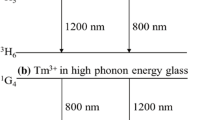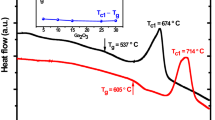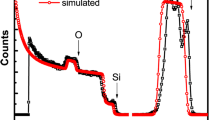Abstract
Enhanced photoluminescence (PL) in a tellurite glass (TeO2–ZnO) doped with erbium ions (Er3+) and containing silicon nanocrystals (Si-NCs) is reported. The PL increase is mainly attributed to energy transfer from excited Si-NCs to the Er3+ located in the vicinity of the nanocrystals although the contribution of active defects in the glass cannot be completely excluded. Enhancement of ≈300 % was observed in the visible and in the near-infrared regions. In particular, the fourfold enhancement observed for the broad emission centered at ≈1530 nm, corresponding to the Er3+ transition 4I3/2 → 4I15/2, indicates large potential of the composite material for interface with existing telecommunication devices.
Similar content being viewed by others
Avoid common mistakes on your manuscript.
1 Introduction
Enhanced photoluminescence (PL) of materials doped with rare-earth ions (REI) has been demonstrated when metallic nanoparticles are present within glass samples [1–10]. Stokes and anti-Stokes PL have been studied, and the mechanisms contributing to PL growth were discussed. An important motivation for this kind of work is the possible application of the composite materials in photonic devices such as color displays, lasers and optical amplifiers. The experiments reported exploit the increased local field in the vicinities of metallic particles or the energy transfer (ET) from the particles to the REI. For a given excitation wavelength, \( \lambda_{\text{ex}} \), the PL intensity enhancement depends on the nature, environment, shape and volume concentration of the metallic particles. When \( \lambda_{\text{ex}} \) is near-resonance with the wavelength of the localized surface plasmons of the nanoparticles, the PL becomes more intense. Large PL enhancements have been reported for different composites, but one drawback of this procedure is the energy loss due to heating of the metallic particles [11].
Another way to obtain PL enhancement of REI has been demonstrated using semiconductor nanocrystals (NCs) [12–21]. The absorption cross sections of the NCs are usually larger than the REI cross sections, and then ET from the NCs to the REI may be an efficient mechanism to achieve PL growth. In this case, the size of the NCs may be adjusted to match their energy gap and the energy of the desired REI emitting states. Various examples of this approach were reported, and the trivalent erbium ion, Er3+, has been the REI mostly investigated because of its strong transition at ≈1.5 µm, in the conventional telecommunication window. In principle, large amplification at ≈1.5 µm may be obtained if large density of excited Er3+ is present.
Demonstrations of Er3+-enhanced PL were based on silicate glass containing silicon nanocrystals, Si-NCs, prepared by techniques such as ion implantation, lithography or chemical vapor deposition [13, 19–25]. Also reported was the PL enhancement of europium ions in silica glass–ceramic waveguides with high SnO2 NCs content [26].
Si-NCs with dimensions of few nanometers have been used because they present direct bandgap and large optical absorption cross section. Moreover, the blueshift of the NCs bandgap, due to electron quantum confinement, may allow ET processes to enhance the PL efficiency of Er3+ in the visible range.
Although the technology of silica-based glasses, optical fibers and planar waveguides is well established, there is interest to identify other glasses with small cutoff phonon energy to be used as host for REI and Si-NCs. Also for applications requiring high nonlinear response, silica is not a good material because of its small nonlinearity [23]. From this point of view, the heavy-metal oxide (HMO) glasses are more competitive than silicate glasses because they have smaller cutoff phonon energies, larger linear refractive index and high nonlinear response. Besides, there is a lack in the literature related to HMO glasses with Si-NCs.
Previously we reported the observation of PL enhancement in Er3+-doped GeO2–Bi2O3 glasses due to the presence of Si-NCs [27]. We observed growth of ≈200 % in the Er3+ emission at 545 nm and ≈100 % for the PL at 525, 660 and 1530 nm. However, when large concentrations of Si-NCs were used, PL quenching was observed specially in the near-infrared.
In the present work, we report results for a tellurite glass (TeO2–ZnO) where we observed larger Er3+ PL enhancements than in the GeO2–Bi2O3 glass. The TeO2–ZnO glass was used because it presents large transmittance from the blue to the infrared, having phonon energies smaller than 800 cm−1, large refractive index (≈2) and high nonlinear optical response [7, 23]. Since Si-NCs with dimensions of 10 nm or larger present indirect bandgap, we considered advantageous to work with samples having large NCs because of the small exciton recombination rate that contributes to increasing the probability of ET to a neighbor Er3+. This choice is also justified by the more simple procedure required for samples preparation than in most of the works using Si-NCs that present quantum-confinement effects.
The samples were excited at 980 nm, and we observed PL enhancement of ≈200 % in the Er3+ transitions 4S3/2 → 4I15/2 and of ≈300 % for transitions 2H11/2 → 4I15/2, 4F9/2 → 4I15/2 and 4I13/2 → 4I15/2. As far as we know, there is no previous report on enhanced PL in REI-doped tellurite glasses containing Si-NCs.
2 Experimental details
The melting-quenching technique was used for samples fabrication with the starting composition: 85 % TeO2–15 % ZnO (in wt%). All samples were prepared with 1.0 wt% of Er2O3 (Sigma-Aldrich—99.9 %) and Si powder concentrations of 0.01, 0.1 and 0.4 wt%. The Si powder was bought from Sigma-Aldrich with grains having nominal average size of 50 nm. Samples without Si-NCs were also prepared to be used as reference in the optical experiments.
The reagents were melted inside a platinum crucible at either 800 or 900 °C, during 20 min. Manual stirring was performed during the melting procedure in order to optimize the transparency of the samples. This procedure was important mainly for the samples with higher Si powder concentration. Then, the melting was poured into preheated brass molds, in air, and annealed at 320 °C for 2 h to reduce internal stress. Finally, the glasses were cooled to room temperature following the cooling inertia of the furnace.
To verify the presence of Si-NCs inside the glass matrix, we used a 300-kV transmission electronic microscope (TEM).
Optical absorption spectra were measured from the blue to the near-infrared using a commercial spectrophotometer. The PL spectra were obtained by exciting the samples with a continuous-wave diode laser operating at 980 nm (1.27 eV), and the PL signals were analyzed using a monochromator equipped with a photomultiplier (for the visible range) and a Ge photodiode (for the near-infrared range). The signals were processed using a lock-in connected to a personal computer. All measurements were taken at room temperature.
3 Results and discussions
Figure 1a–d shows TEM images of samples prepared using different melting temperatures and Si grain concentrations. Si-NCs with average sizes of 20 and 50 nm were obtained with melting temperatures of 800 and 900 °C, respectively. The high-resolution TEM images revealed the crystalline structure of the NCs. For Si-NCs with the sizes observed here, we do not expect quantum-confinement effects since the exciton Bohr radius in bulk Si crystals is ≈4.3 nm [13]; moreover, on the basis of the results of [24, 25], we know that the Si-NCs in our samples exhibit indirect bandgap.
Figure 2 shows a representative absorption spectrum of Er3+-doped TeO2–ZnO samples with Si-NCs. Absorption bands typical of the 4f–4f transitions starting from the Er3+ ground-state manifold (4I15/2) are observed, and they are labeled by the final state of the transition. All bandwidths are inhomogeneously broadened due to the site-to-site crystal-field variations. The positions of the Er3+ bands did not change in the samples with Si-NCs.
Figure 3a, b shows the PL spectra of the samples melted at 800 °C, while Fig. 3c, d shows the results for the samples melted at 900 °C. The PL spectra for samples without Si-NCs are also shown for reference. The bands observed correspond to the transitions 2H11/2 → 4I15/2 (≈525 nm), 4S3/2 → 4I15/2 (≈545 nm), 4F9/2 → 4I15/2 (≈680 nm) and 4I13/2 → 4I15/2 (≈1530 nm). Note that for the samples melted at 800 C, the signals at 545 and 1530 nm are enhanced by ≈200 % in comparison with the sample without Si-NCs. PL quenching of the visible emission and larger enhancement of the 1530-nm emission are observed in the sample prepared with 0.4 wt% of Si powder. On the other hand, the samples melted at 900 °C present quenching of the visible PL, but a large enhancement of ≈300 % is observed for the 1530-nm emission in the sample prepared with 0.4 wt% of Si powder.
Figure 4 shows a plot of the PL intensity versus the laser intensity for the signals at 545 and 1530 nm emitted by the samples melted at 800 °C. The samples, without Si-NCs and the samples prepared with 0.4 % of Si powder, show quadratic (linear) dependence of the PL intensity at 545 nm (at 1530 nm) versus the laser intensity. The PL intensity dependence for the samples melted at 900 °C is similar. The slopes of the lines in Fig. 4 indicate that two laser photons generate one photon in the visible range, while only one laser photon is involved in the generation of each photon at 1530 nm. These processes are similar to the ones observed in [27] for the GeO2–Bi2O3 glasses. In the samples without Si-NCs, the PL in the green range is due to a stepwise two-photon transition (4I15/2 → 4I11/2 → 4F7/2) followed by nonradiative decay to states (2H11/2, 4S3/2) followed by radiative decay to the ground state. The emission at 1530 nm (4I13/2 → 4I15/2) is due to the excitation of Er3+ to state 4I11/2 (due to its direct laser excitation or decay from higher energy states) followed by nonradiative relaxation to state 4I13/2 and then by radiative transition to the ground state.
Narrowing of the emission bands due to the presence of Si-NCs was not observed, indicating that the amount of Er3+ inside the nanocrystals is negligible, in agreement with [28] that reported small solubility of Er3+ in Si.
From the results obtained, it is clear that the Si-NCs play an important role changing the relative amplitudes of the PL transitions. Assuming that the main contribution to the enhanced PL is due to the Si-NCs, we may interpret the results in the following way. First, we recall that Si-NCs with diameters of 20 nm or larger do not present quantum confinement and their energy bandgap does not differ much from the bandgap of bulk silicon (1.12 eV). Then, since the energy of the laser photons is 1.27 eV, a direct one-photon excitation of the Si-NCs besides the resonant excitation of the Er3+ is expected. Therefore, the enhancement of the emission at 1530 nm in the samples with Si-NCs may be attributed mainly to ET from one excited Si-NC to one Er3+ located in its proximity. The PL enhancement at 545 nm is attributed to ET from two excited Si-NCs to one Er3+ initially in the ground state. The PL quenching in the visible range may be attributed to back-energy transfer from excited Er3+ to the Si-NCs. PL quenching is expected to be larger in the samples with higher Si-NCs concentration as well as in the samples with the larger Si-NC sizes. This PL quenching together with the larger enhancement observed in the sample melted at 900 °C is attributed to the high absorption cross section of the Si-NCs and indicates that more Er3+ are located in the vicinities of the Si-NCs than in the samples melted at 800 °C.
Other excitation channels could also contribute to the PL enhancement such as active defects, e.g., nonbridging oxygen centers in the glass network, surface states in the Si-NCs or aggregates formed by the Si-NCs able to absorb incident photons and transfer the absorbed energy to Er3+. Since extra features besides the Er3+ transitions were not observed in the absorption spectra neither in the PL spectra, we expect a small contribution of defects to the PL enhancement. However, future investigation of the PL temporal behavior, as in Ref. [29], should be made to verify the influence of active defects for the present results.
In summary, we emphasize that this report presents a new procedure for PL management in tellurite glasses as an alternative method of using metallic nanoparticles. The mechanism exploited here was the ET from the excited Si-NCs to the erbium ions. Because the large Si-NCs in the samples have indirect bandgap, the exciton recombination rate is small and then the ET process from the Si-NCs to Er3+ is favored. The possibility to nucleate Si-NCs inside tellurite glasses, herein demonstrated for the first time using a simple technique, opens new routes for the use of other REI appropriate for various photonic applications such as color displays, amplifiers and sensors. In principle, the present scheme of excitation can be applied to investigate the potential of Si-NC-doped TeO2–ZnO for integrated optics as in [30] where a silica-based glass was used.
References
O.L. Malta, P.A.S. Cruz, G.F. de Sá, F. Auzel, J. Lumin. 33, 261 (1985)
T. Hayakawa, S.T. Selvan, M. Nogami, Appl. Phys. Lett. 74, 1513 (1999)
L.P. Naranjo, C.B. de Araújo, O.L. Malta, P.A.S. Cruz, L.R.P. Kassab, Appl. Phys. Lett. 87, 24194 (2005)
V.K. Rai, L. de S. Menezes, C.B. de Araújo, L.R.P. Kassab, D.M. da Silva, R.A. Kobayashi, J. Appl. Phys. 103, 093526 (2008)
L.R.P. Kassab, D.S. da Silva, R. de Almeida, C.B. de Araújo, Appl. Phys. Lett. 94, 101912 (2009)
L.R.P. Kassab, L.F. Freitas, T.A.A. Assumpção, D.M. da Silva, C.B. de Araújo, Appl. Phys. B 104, 1029 (2011)
C.B. de Araújo, D.S. da Silva, T.A.A. de Assumpção, L.R.P. Kassab, D.M. da Silva, Sci. World J. 2013, 385193 (2013)
T. Som, B. Karmakar, J. Appl. Phys. 105, 013102 (2009)
V.A.G. Rivera, S.P.A. Osorio, Y. Ledemi, D. Manzani, Y. Messaddeq, L.A.O. Nunes, E. Marega Jr, Opt. Express 18, 25321 (2010)
R.J. Amjad, M.R. Sahar, M.R. Dousti, S.K. Ghoshal, M.N.A. Jamaludin, Opt. Express 21, 14282 (2013)
P.N. Prasad, Nanophotonics (Wiley, New Jersey, 2004)
A.A. Bol, R. van Beek, A. Meijerink, Chem. Mater. 14, 1121 (2002)
D.J. Lockwood, J. Mater. Sci. Mater. Electron. 20, S235 (2009)
L. Yu, H. Liu, J. Nanomater. 2010, 461309 (2010)
M.J.A. de Dood, J. Knoester, A. Tip, A. Polman, Phys. Rev. B 71, 115102 (2005)
X.L. Wu, Y.F. Mei, G.G. Siu, K.L. Wong, K. Moulding, M.J. Stokes, C.L. Fu, X.M. Bao, Phys. Rev. Lett. 86, 3000 (2001)
R.A. Senter, C. Pantea, Y. Wang, H. Liu, T.W. Zerda, J.L. Coffer, Phys. Rev. Lett. 93, 175502 (2004)
E.F. Pecora, T.I. Murphy, L.D. Negro, Appl. Phys. Lett. 101, 191115 (2012)
Device Applications of Silicon Nanocrystals and Nanostructures. Edited by N. Koshida, Series: Nanostructure Science and Technology (Springer, New York, 2009)
A.J. Kenyon, Prog. Quantum Electron. 26, 225 (2002)
F. Priolo, G. Franzò, D. Pacifici, V. Vinciguerra, F. Iacona, A. Irrera, J. Appl. Phys. 89, 264 (2001)
A. Irrera, F. Iacona, G. Franzò, M. Miritello, R.L. Savio, M.E. Castagna, S. Coffa, F. Priolo, J. Appl. Phys. 107, 054302 (2010)
M. Yamane, Y. Asahara, Glasses for Photonics (Cambridge University Press, Cambridge, 2000)
C. Meier, A. Gondorf, S. Lüttjohann, A. Lorke, H. Wiggers, J. Appl. Phys. 101, 103112 (2007)
C. Delerue, G. Allan, M. Lannoo, Phys. Rev. B 48, 11024 (1993)
S.N.B. Bhaktha, F. Beclin, M. Bouazaoui, B. Capoen, A. Chiasera, M. Ferrari, C. Kinowski, G.C. Righini, O. Robbe, S. Turrel, Appl. Phys. Lett. 93, 211904 (2008)
D.S. da Silva, L.P. Naranjo, L.R.P. Kassab, C.B. de Araújo, Appl. Phys. B 106, 1015 (2012)
D.J. Eaglesham, J. Michel, E.A. Fitzgerald, D.C. Jacobson, J.M. Poste, J.L. Benton, A. Polman, Y.H. Xie, L.C. Kimerling, Appl. Phys. Lett. 58, 2797 (1991)
E. Almeida, L. de S. Menezes, C.B. de Araújo, A.A. Lipovskii, J. Appl. Phys. 109, 113108 (2011)
J. Clement, R.G. de Corby, N. Ponnampalam, T.W. Allen, A. Hryciw, A. Meldrum, Opt. Express 14, 12151 (2006)
Acknowledgments
We acknowledge financial support from the Brazilian Conselho Nacional de Desenvolvimento Cientifico e Tecnológico (CNPq) and the Fundação de Amparo à Ciência e Tecnologia do Estado de Pernambuco (FACEPE). This work was performed with financial support of the National Institute of Photonics (INCT de Fotônica) project and PRONEX program, a joint initiative of FACEPE and CNPq.
Author information
Authors and Affiliations
Corresponding author
Rights and permissions
About this article
Cite this article
da Silva, D.S., de Assumpção, T.A.A., de Simone, G.B.C. et al. Enhanced Er3+ photoluminescence in TeO2–ZnO glass containing silicon nanocrystals. Appl. Phys. B 121, 117–121 (2015). https://doi.org/10.1007/s00340-015-6207-9
Received:
Accepted:
Published:
Issue Date:
DOI: https://doi.org/10.1007/s00340-015-6207-9








